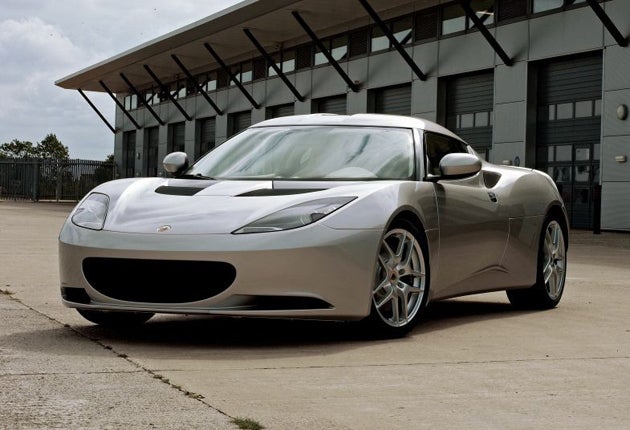Lotus Evora
Could this be the best-handling car on the planet?

You will surely have seen images of the Lotus Evora. It was the star of last summer’s London motor show, and it has fired much enthusiasm in the specialist motoring press as the first all-new Lotus since 1996. The sun is shining on Lotus’s Norfolk factory.
It was to this factory that I drove last week, in my own 41-year-old Lotus because it seemed appropriate. It got me there, which was a relief in itself, and it kept me mindful of the vital Lotus attributes of lightness, compactness, suppleness and complete immersion of the driver in the process of interacting with the car. That was how Lotus founder Colin Chapman thought cars should be, and the philosophy remains.
But the Evora is bigger, grander, more expensive. And although it looks a bit like a big Elise with a hardtop, it’s actually a four-seater.
No. Make that a two-plus-two. I am not remotely tall, but I can’t sit behind myself, metaphorically speaking, in an Evora. Nowhere for knees, nowhere for head. But a child or two would fit, and that’s the point. This is more than a self-indulgent, two-seater sports car. Or coupé. Or GT.
For now, all Evoras have a solid, fixed roof but a convertible will follow. So will a cheaper version with no rear seats, and an automatic. Like the Elise and its derivatives, the Evora has its engine mounted across the car behind the occupants with the boot beyond, and a chassis made from bonded and riveted aluminium sheets and extrusions. But everything is bigger and more sophisticated, because the Evora has to take on rivals such as
Porsche’s Cayman and not fall at the first hurdles of quality and refinement.
That’s a big challenge for a small factory. Porsche makes more cars in a year than Lotus has made in its entire 60-year history to date, but buyers of a £47,500 car (the cheapest, option-free, two-seats-only Evora) won’t accept quality solecisms just because the car isn’t replicated as often. What might pass in an Elise won’t do in an Evora.
There is no doubt whatsoever about an Evora’s strength, though. Lotus built six cars for crash tests but needed to use just four of them, because two could be rebuilt and used again. It’s the first time this has happened, and is due partly to the replaceable front and rear chassis sections.
In the steel rear section sits a 3.5-litre V6 engine from Toyota, sending its power through a six-speed manual gearbox from a Toyota Avensis diesel. The V6 is normally found in a US-market Camry, but its character is radically changed for the Evora thanks to Lotus’s own control systems. It makes 280bhp, yet is very light on CO2.
Inside the Evora is a sense of quality and attention to detail ahead of anything Lotus has attempted before. Leather is all around, at least in this “launch edition” Evora (the first 450 cars) with Tech, Premium and Sport packs and a stack of other options which together hoist the price to £59,900. It’s not quite right, though. The driver’s door shudders when pulled shut. The Alpine stereo and sat-nav display screen looks cheap with its fiddly, ugly silver buttons along the bottom. The red information display screens either side of the instruments are hard to read in sunlight or if you are long-sighted.
And, in Elise fashion, there’s far too much tyre noise on a concrete surface, such as the nearby A11. But I find myself not caring that much, because the short series of twists between factory and A-road have just revealed the Evora to be possibly the best-handling, most dynamically capable car on the planet.
That’s a big accolade. Let me elaborate. It has the flow and the lightness of touch that is the Lotus speciality, but its power steering has much more feedback – kickback even, over bumps – than is normal in expensive cars today. Some may dislike this but I love it. You can feel the huge grip, the way the nose bites into the bend and the tail obediently follows. More power and it just bites harder, the engine humming a deep, powerful tune and pulling hard right through its rev range.
This gearbox has the “sports” ratios which worsen the rated, if not the real-world, CO2 – but let the engine give its best. They’re a must-have. And then you discover the suppleness of the ride and the indefatigable power of the brakes, and you realise that all the time you have been sitting in perfect seat comfort. This is a civilised machine as well as an intensely thrilling one, somehow more subtle in its feel than a Porsche Cayman and ultimately even more capable. That’s praise indeed.
Join our commenting forum
Join thought-provoking conversations, follow other Independent readers and see their replies
Comments